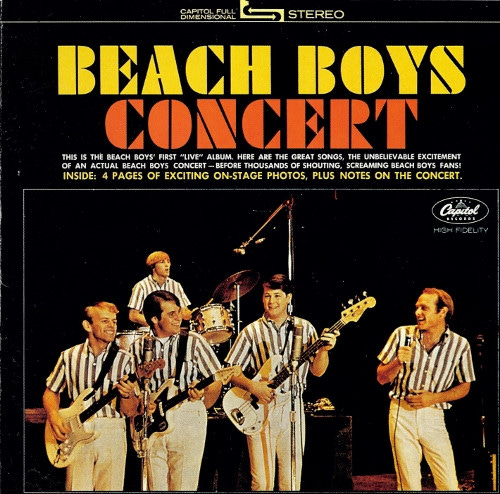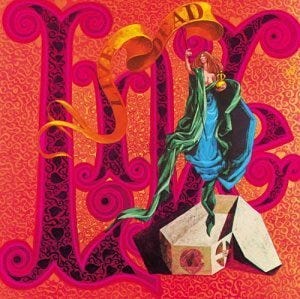Today I’m sharing the 16th installment of the Play All Night Playlist Project.
It accompanies Chapter 12 of Play All Night, “Recording At Fillmore East (March 12–13, 1971).”
New Photos of the Fillmore East sessions
Richard Edelman took these shots from the Friday, March 12, 1971 early show. This was the 3rd show of the run.1
You’ll see three “new” folks onstage with the Brothers: Juicy Carter (sax), Thom “Ace” Doucette (harmonica, cigarette), and Bobby Caldwell (percussion) from Johnny Winter’s Band. All were favorite collaborators of Duane’s.2
Richard remembers headliner Johnny Winter watching the set from behind Gregg. Johnny saw something he couldn’t top and demanded to switch places with the Allman Brothers Band for the late show.
This gave the ABB three, 90+ minute sets, which the band recorded every second of. The entirety of At Fillmore East—and two tracks from Eat a Peach—comes from these three shows.
None comes from the show where Richard snapped these photos, but the audio was released in 2014 on the 1971 Fillmore East Recordings (see next section).
At Fillmore East
Here’s part 1, a deep dive on the album At Fillmore East. This record has been released a zillion times. I honestly don’t know the best sounding versions that circulate.
Three playlists to familiarize yourself with the album:
At Fillmore East original, 7-song album (Spotify / Youtube)3 You can never, ever go wrong with the original record.
At Fillmore East: Play All Night! Edition (Spotify) This is the playlist I listened to as I wrote Play All Night! because it’s got “Mountain Jam” tagged onto the end. It’s incomplete to me otherwise.4
The 1971 Fillmore East Recordings (Spotify / Youtube) The complete recordings of the ABB’s March 1971 sessions plus the 6/27/71 closing show at the Fillmore East. I’ll do more exploration of this set at a later date.
Original versions
Pre-Fillmore versions of “Hot’Lanta” don’t stream. But the rest of the playlist is made up of the tunes the ABB adapted for At Fillmore East—4 covers and 3 originals.
Spotify Playlist
Taj Mahal “Statesboro Blues” Whether it was a live gig (as Paul Hornsby and Johnny Sandlin said) or the album cut (as Gregg Allman remembered), it was Jesse Ed Davis’s bottleneck playing on this song that got Duane started on slide.5
Blind Willie McTell “Statesboro Blues” The ABB never recorded an acoustic version of this track, but they regularly paid homage to McTell when introducing the song.
Elmore James “Done Somebody Wrong”—which Duane introduced as “An old, true story.”
T-Bone Walker “Call it Stormy Monday” and Bobby “Blue” Bland “Stormy Monday Blues” Duane introduces it first by the inspiration for the arrangement (Bland). I included both versions for context.
Junior Wells/Buddy Guy “You Don’t Love Me Baby” the Allman Brothers Band completely remade this song. Clocking in at around 6 minutes at Stonybrook July 10, 1970, it expanded to nearly 20 minutes within six months.
The album had three Allman Brothers Band originals:
“In Memory of Elizabeth Reed” from Idlewild South6
“Hot ‘Lanta” gave y’all an outtake from the Fillmore East sessions. This was the encore of the Friday night late show, back when bands earned encores.7 Includes Juicy Carter’s final appearance for the run.
“Whipping Post” this version, from the debut album has always seemed so tame in comparison to the 23-minute tour-de-force on At Fillmore East.
Live albums from Chapter 12
For Duane to insist that his band release a live album recorded on the biggest stage in rock was a bold move.
Part of making the case for Why At Fillmore East? was looking at the evolution of the live album. The Allman Brothers Band had yet to break out of the rock underground. And releasing a live album of a relatively unknown band was pretty much unheard of.
Some artists used live albums to introduce new material or change musical direction.
John Coltrane’s Coltrane “Live” at the Village Vanguard did both.
Johnny Cash’s At Folsom Prison and At San Quentin established Cash as the Man in Black.
For many, live releases were a regular course of business.
James Brown Live at the Apollo was a self-funded project to reestablish Brown on the charts. (It was a massive success)
Most records, like Muddy Waters At Newport 1960 and B.B. King Live at the Regal failed to chart altogether.
It took until the mid-1960s for executives to realize the youth market for live albums.
Beach Boys’ Beach Boys Concert was the breakthrough. Released in 1964, it spent sixty-two weeks on the charts, four of them at #1.
The Rolling Stones got LIVE if you want it released in 1966, hit #6


Both records were heavily overdubbed in post-production, an open secret in the industry. Said Dickey:
“There was kind of a running joke in the music business. Nobody said it in public in an interview or anything, but people would say, ‘The only thing live on such-and-such record was the audience.’ A lot of times they would go back into the studio and redo things; redo vocals and stuff.”8
Soon labels began including live tracks on studio albums.
Eric Clapton’s career was at the forefront of this trend, first with the Yardbirds, and later with Cream.
The Yardbirds Having a Rave Up with the Yardbirds After Clapton wrapped up his tenure with the Yardbirds, his label slapped four of his live cuts on this 1965 album.
Cream Half of the tracks, among them “Crossroads,” were live on Cream’s final two albums, Wheels of Fire (1968) and Goodbye Cream (1969).
Once again, the Dead led the pack.
Grateful Dead Live/Dead (1969) Whether the Allman Brothers Band considered Live/Dead as a model for At Fillmore East is immaterial.
The connection matters most because these two similarly influenced, influential, innovative, improvisational bands decided their best showcase was an album that captured the live experience. It was how they best expressed themselves.
Live/Dead didn’t sell well, only reaching #64 in 15 weeks on the charts. But it sounded as close to the experience of a live Grateful Dead concert as possible, and it brought in new fans along the way.
The ABB sought the same results two years later with At Fillmore East.
Thanks for reading.
It’s good to have you here.
To support my work, consider a paid subscription.
Candlesticks always make a nice gift.
And remember, sharing is caring.
The band played 6 shows: Thursday, March 11; Friday, March 12; Saturday, March 13. Tapes of the Thursday shows (if there were any) don’t survive.
Caldwell is the seventh member Duane talks about in his WABC interview, 12/9/70. I’ve got the link queued up to the mention of a just-hired new member, but you really should check out the whole clip. Duane’s in rare form at the beginning of this interview.
Don’t miss the shout-out at about 16:18 in “You Don’t Love Me”
I also added “Little Martha” as a little bit of nostalgia for us old heads.
Duane gave Taj props a couple of months earlier at Syria Mosque in Pittsburgh.
For backstory on the origin of the song—and Elizabeth Jones Reed Napier’s myriad connections to the Allman Brothers Band story, check out my post “Who is Elizabeth Reed? She’s more than just the inspiration for the title of the great Dickey Betts instrumental.”
You can hear the crowd bellowing “More!” “More!” “More!” in the silence after the band finished “Whipping Post.” A reminder that this cut wouldn’t have been possible had Johnny Winter not switched places with the ABB on the Fillmore East bill.
Play All Night, p172. Remember, At Fillmore East contains ZERO overdubs.








Nailed it as usual Dr. B. THANX
Good morning Bob
I feel like I'm witnessing and documenting something very akin to what it was like to be around the Allman's in the years leading up to 1969 as I follow Melody Trucks and the Fitzkee Bros on their Road to Roots 2024 Tour. There's so many common elements...there's a visionary Trucks, there are talented brothers...all of them from beach towns, one of them Jacksonville, playing in beach bars, with the best folks they can find. They have the same Roots with Muddy and the Wolf, among others. This band has the youthful power of the what became the ABB with the added benefit of a wise mentor who grew up with the real deal...hearing her dad's VERY rich stories. To hear this catalog of music, played with this level of technique, enthusiasm and sheer joy is a real treat.
I've shot a lot of bands...a lot of big name national acts...and i'm engaged in and enjoying this process of discovery and artistry more than almost any I've ever experienced through my lens.
This is a top 5 experience...it makes me appreciate Jim Marshall and Stephen Paley...(with less envy now) . Last night at what I'm calling "Zen Fillmore West" was epic and very Deja Vu of the shows Bill Graham did...in a smaller, but similar venue, with 4 complimentary acts on the bill. The "under" 3 were all local to Baltimore. The opener set a very high bar. Wait until you see the video.I told their very able percussionist that he reminded me of a young Airto, who I've seen live at least 4-5 times, mostly with Weather report, but also with his wife Flora. I was surprised this percussionist did not know of the great and wild Airto...he had some googling to do. This has been a blast...Melody and her partner in crime Chantel are doing a wonderful thing....and I'm very happy to be on the ride. Peace & Love brother